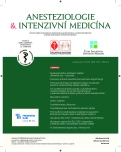Contribution of brain dormancy to clinical signs of brain damage and the possibility of its treatment by zolpidem
Authors:
Augustini Lucie 1; Gabrhelík Tomáš 2; Adamus Milan 1
Authors‘ workplace:
Rehabilitační oddělení NsP Nový Jičín
1; KARIM FN a LF UP v Olomouci, Olomouc
2
Published in:
Anest. intenziv. Med., 24, 2013, č. 1, s. 26-32
Category:
Anesthesiology - Review Article
Overview
Most of the various types of brain injuriy are supposed to be connected with neuroprotective supression of brain activity, so-called brain dormancy. The reason for this suppressed neuronal activity is protection of brain tissue from damage. However reduction in neuronal energy metabolism and function makes the clinical symptoms more serious. Later after brain injury inception, brain dormancy and suppression offer no benefit. Currently many experimental advances, pharmacological and non-pharmacological, are being made to achieve brain dormancy switch-off. One of drugs frequently used to restore brain function is zolpidem.
Keywords:
brain dormance – brain tissue damage – GABA – zolpidem – vegetative state – treatment of brain injury consequence
Sources
1. Lippertová-Grünerová, M. Trauma mozku a jeho rehabilitace. 1. vyd. Praha: Galen, 2009, ISBN 978-80-7262-569-7.
2. Kuschinsky, W. Krevní oběh mozku, hematoencefalická bariéra, mozkomíšní mok. In Folsch, S. et al. Patologická fyziologie. Praha: Grada Publishing, 2003, s. 163–172, ISBN 80-247-0319-X.
3. Vožeh, F. Mechanismy excitotoxicity. In Hulín, V. et al. Patofyziológia. 7. vyd. Bratislava: FABER, 2009, s. 1119–1122, ISBN 978-80-8095-043-9.
4. Clauss, R. P., Nel, W. Drug induced arousal from the permanent vegetative state. NeuroRehabilitation, 2006, roč. 21, s. 23–28.
5. Singh, R., McDonald, C., Dawson, K., Lewis, S., Pringle, A. M., Smith, S., Pentland, B. Zolpidem in a minimally conscious state. Brain Injury, 2008, roč. 22, 1, s. 103–106.
6. Giacino, J. T., Hirsch, J., Schiff, N., Laureys, S. Functional neuroimaging applications for assessment and rehabilitation planning in patients with disorders of consciusness. Arch. Phys. Med. Rehabil., 2006, roč. 87, 2, s. 67–76.
7. Clauss, R. P., Güldenpfennig, W. M., Nel, H. W., Sathekge, M. M., Venkannagari, R. R. Extraordinary arousal from semi-comatose state on zolpidem. SAMJ, 2000, roč. 90, s. 68–72.
8. Clauss, R. P. Evidence for zolpidem efficacy in brain damane. Pharm. Pract., 2005, roč. 47, 3, s. 49–50.
9. Cohen, L., Chaaban, B., Habert, M. Transient improvement of aphasia with zolpidem. N. Engl. J. Med., 2004, roč. 350, 9, s. 949–950.
10. Shames, J., Ring, H. Transient reversal of anoxic brain injury – related minimally conscious state after zolpidem administration: A case report. Arch. Phys. Med. Rehabil., 2008, roč. 89, 2, s. 386–388.
11. Cohen, S., Duong, T. Increased arousal in a patient with anoxic brain injury after administration of zolpidem. Am. J. Phys. Med. Rehabil., 2008, roč. 87, 3, s. 229–931.
12. Thomas, P., Cottencin, O., Rascle, C., Vaiva, G., Goudemand, M., Bieder, J. Catatonia in French Psychiatry: Implications of the zolpidem challenge test. Psychiatric. Annals, 2007, roč. 37, 1, s. 45–54.
13. Daniele, A., Albanese, A., Gainotti, G., Gregori, B., Bartolomeo, P. Zolpidem in Parkinson’s disease. Lancet, 1997, roč. 349, s. 1222–1223.
14. Chen, Y., Sy, H., Wu, S. Zolpidem improves akinesia, dystonia and dyskinesia in advanced Parkinson’s disease. J. Clin. Neurosci., 2008, roč. 15, s. 955–956.
15. Shadan, F., Poceta, J., Kline, L. Zolpidem for postanoxic spasticity. Southern Medical Journal, 2004, roč. 97, 8, s. 791–792.
16. Whyte, J., Myers, R. Incidence of clinically significant responses to zolpidem among patients with disorders of consciousness. Am. J. Phys. Med. Rehabil., 2009, roč. 88, 5, s. 410–418.
17. Lazzaro, V., Pilato, F., Dileone, M., Ranieri, F., Ricci, V., Profice, P., Bria, P., Tonali, P.A., Ziemann, U. GABAA receptor subtype specific enhancement of inhibition in human motor cortex. J. Physiol., 2006, roč. 575, 3, s. 721–726.
18. Brefel-Courbon, C., Payoux, P., Ory, F., Sommet, A., Slaoui, T., Raboyeau, G. et al. Clinical and imaging evidence of zolpidem effect in hypoxic encephalopathy. Annals of Neurology, 2007, roč. 62, 1, s. 102–105.
19. Hall, S., Yamawaki, N., Fisher, A. E., Clauss, R. P., Woodhall, G. L., Stanford, I. M. Desynchronization of pathological low-frequency brain activity by the hypnotic drug zolpidem. Nature Precedings, 2008, roč. 23, s. 6–11.
20. Nyakale, N. E., Clauss, R. P., Nel, W., Sathekge, M. Clinical and brain SPECT scan response to zolpidem in patients after brain damage. Arzneimittelforschung, 2010, roč. 60, 4, s. 177–181.
21. Clauss, R. P. Neurotransmitters in coma, vegetative and minimally conscious states, pharmacologicals interventions. Medical hypotheses, 2010, roč. 75, 3, s. 287–290.
22. Hall, S., Yamawaki, N., Fisher, A. E., Clauss, R. P., Woodhall, G. L., Stanford, I. M. GABA(A) alpha-1 subunit mediated desynchronization of elevated low frequency oscillations alleviates specific dysfunction in stroke – A case report. Clinical neurofysiology, 2010, roč. 121, 4, s. 549–555.
23. Oliveira, L., Fregni, F. Pharmacological and electrical stimulation in chronic disorders of consciousness: New insights and future directions. Brain Injury, 2011, roč. 25, 4, s. 315–327.
24. ReGen Therapeutics. Pharmaceuticals – Zolpidem. [online]. 2009 Dec; [cit. 2012-4-28]. Dostupné na: www.regentherapeutics.com/rtl/products/zolpidem/>
Labels
Anaesthesiology, Resuscitation and Inten Intensive Care MedicineArticle was published in
Anaesthesiology and Intensive Care Medicine

2013 Issue 1
Most read in this issue
- Physical principles of ultrasound
- Current view of anaesthesia for carotid surgery
- Bouveret syndrome
- Effect of combination of prone position and high-frequency oscillatory ventilation on blood gas exchange in experimental model of acute respiratory distress syndrome
